Florence and its Plain - Historical-Archaeological Testimonies
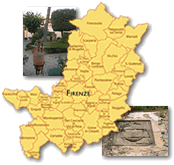
The countryside around the city of Florence has a more ancient history than the capital city itself. Indeed, during the Etruscan epoch, this territory was headed by the powerful city-state of Fiesole, which even promoted the reclamation of the plain, creating a draining system maintained by the centuriation of the Roman epoch. Even after antiquity, Fiesole continued to be an important communal city, definitively falling to Florence only in 1125.
The ideal point of departure for an itinerary which intends to discover the territory’s archaeological past can only be the Museo Archeologico Nazionale, housed in Palazzo della Crocetta in the historical centre of Florence, where Egyptian, Etruscan and Roman collections offer a complete panorama of the region’s history.
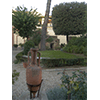
In 1870, when Florence was capital of the Kingdom of Italy, Victor Emanuel II instituted the "Etruscan" Museum alongside the "Egyptian" one, on the premises of the Monastery of Sant'Onofrio (known as Fuligno) in Via Faenza. In 1881 the collections were moved to Via della Colonna, where they became part of the Royal Archaeological Museum. The current arrangement displays a good part of the Medici-Lorraine collection of Etruscan, Greek and Roman antiquities, which had previously been exhibited in the Uffizi Gallery, and some of the objects from the Etruscan topographic section of the Museum, damaged during the flood of 1966 and subsequently restored. The Archaeological Museum, located in the seventeenth-century Palazzo della Crocetta, also houses the Egyptian Museum, in Italy second in importance only to that of Turin.
Among the objects of scientific interest found in the Museum is a small collection of measurement instruments of various kinds, from Egyptian, Etruscan and Roman times. They consist of balances and lever scales with the relevant weights, measures of capacity, a model of a cubit and devices for measuring time from ancient Egypt.
Of exceptional interest is the monumental garden, laid out already in the 16th century at the order of Cosimo II de' Medici, but extensively remodelled in the following centuries. Little remains of the arrangement dating from the first half of the 18th century designed by the gardener of Boboli, Francesco Romoli, who laid out a dozen or so regular beds in which citrus trees were planted. The garden as it appears today was planned, instead, by the Museum's first director, Luigi Milani, who in the early years of the 20th century had placed there Etruscan tombs discovered at that time and removed from their original sites. To these were added boundary stones and statues, in a layout that, in the intention of the director, was designed to link the garden conceptually to the ground floor of the Palazzo, where the Museum's topographical collection was displayed.
(Elena Fani)
Leaving Florence eastwards, halfway up the hill that leads to Fiesole, on the right is a road that leads to the quarries at Maiano, which was not only the principal quarrying area of arenaceous stone, for centuries exploited by Florentine quarriers, but also a spot closely tied to Leonardo and his daring experiments on flight.
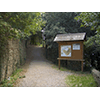
The quarries of Fiesole, and of Maiano in particular, exploited until the early 20th century, are famous for their sandstone, the so-called "pietra fiesolana", amply utilised by sculptors since the 15th century. Mentioned by Benvenuto Cellini and Giorgio Vasari, "pietra fiesolana" was most suitable for architectural works and monuments, as well as for more or less refined elements used for civil, religious and urban furnishings. It was so widely used that the Medicean government had to exert a severe policy of control over its exploitation. In the 17th and 18th centuries, in fact, the Fiesole quarries were "banned" and reserved exclusively to Florentine monuments. Among the last works built with "pietra fiesolana" are the columns in the courtyard, the stairway and other architectural elements of the Florence National Central Library. Today the area has become a park, along whose itineraries can be seen the basic features of the ancient quarries: the cut, the open-sky, and the stone quarry "cava ficcata", artificial caves supported by feet.
Montececeri is a "Leonardian place". In a clearing on the top of the hill, a stele bears the prophecy of flight from "Monte del Cigno" (Montececeri) noted by Leonardo on the inner cover of the "Codex on the Flight of Birds" now in the Royal Library of Turin.
Leonardo also mentions "Monte Ceceri" in drawing the contour of the hills around Florence on Folio 20v of tMadrid Ms. II.
In the vicinity of the Il Regresso curve, along the provincial road that links Fiesole to Florence, a plate on the wall of Villa La Torrossa recalls that Leonardo da Vinci decided to attempt human flight here, from Montececeri. Legend has it that Zoroastro da Peretola (the illegitimate son of one of the Rucellai, a pupil of Leonardo in Milan and in Florence, during the period of the wall painting depicting the Battle of Anghiari, who later died in Rome and is recalled as an esoteric personage) attempted to fly from Montececeri, ending in a disastrous fall.
Maiano is also linked to the figure of Temple Leader, the Englishman who rebuilt the castle of Vincigliata in the 19th century.
(Anna Toscano, Graziano Magrini)
Once back on the road to Fiesole, and having reached the main square of the town, you will find the archaeological area in a vast park. Here you will find interesting vestiges of Roman architecture and hydraulic engineering of the epoch.
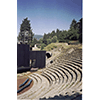
In antiquity Fiesole owed its fortune to its strategic position for controlling the roads linking central-southern Etruria to the Po Valley. The area, already urbanised in the archaic period, has undergone numerous changes over the course of time, the most important of them in the IV century B.C., when the centre was surrounded by an imposing circle of walls over 2,500 meters long.
Dating instead from the beginning of the Augustan Age (late I century B.C.), are the remodelling of the Etruscan temple, the construction of the Roman theatre and the public baths. Although partially rebuilt, the theatre constitutes one of the best-preserved examples in Tuscany. Semicircular in shape, it conserves, original, part of the cavea and of the vomitoria, the original entrances, of which big blocks of stone survive. At the top of the cavea remain traces of the covered gallery (crypta) giving access to the tiers of seats while, unfortunately, nothing has been conserved of the ancient three-doored stage front (scaena frons)
Regarding the public baths, still recognisable are the two outdoor swimming pools and the parts that were originally roofed over: the calidarium, with its system of suspensurae (little terracotta pillars of circular or square shape that served to support the floor, allowing hot air to circulate under it), the tepidarium and the frigidarium.
Within the archaeological zone today is the Archaeological Civic Museum which, in addition to displaying materials coming from the excavations and the collections of antiquarians, organises temporary exhibitions and workshops in Experimental Archaeology.
In the summer months, the Roman theatre finds again its ancient destination as a place for the performance of cultural and musical events, held in connection with the Estate Fiesolana (Summer in Fiesole).
(Elena Fani)
A logical conclusion to the suggested itinerary would be a visit to the tombs of Mula and Montagnola, the most ancient architectural testimonies of the Florentine plain, visible by appointment. The two Etruscan graves are situated close to one another at Quinto and Sesto Fiorentino, and located 12 kilometres from Florence.
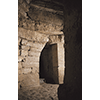
In the Quinto Alto locality are still to be found two of the most important Etruscan architectural monuments: the great tholos tombs (with false cupola) of Montagnola and Mula. They owe their fame to the splendid state of conservation of the structures, which bear witness, for the orientalizing age (7th century B.C.), to the utilisation of an architectural technique similar to that of the monumental tombs at Mycenae, among them the so-called Treasure of Atreus.
As compared to other false-cupola tombs – those of Populonia, for instance – these tombs differ not only in the circular layout of the main chambers, but above all in their remarkable size: a diameter of 5 metres for the Montagnola Tomb, over 8 for that of Mula, dimensions involving notable technical difficulties as regards construction and stability.
The Montagnola Tomb appears as a tumulus with diameter of nearly 70 meters, originally bounded by blocks of clay-rich limestone and waterproofed by a layer of clay. It is entered through an open dromos (corridor) leading to an inner corridor with pseudo-vault, on either side of which are two small rectangular cells. A narrow ogive door opens into the main chamber, which is covered by rows of progressively projecting slabs of stone resting on a vertical socle 3 meters high. The summit is closed by a square slab supported by a pilaster, which, however, does not seem to have a true static function.
Entirely without a central support is the great tholos of the Mula Tomb, which was incapsulated in the sixteenth-century Villa Garbi Pecchioli to be used as a wine-cellar. With part of its dromos demolished on that occasion, it differs from the Montagnola Tomb in that it has no socle in the chamber. Perhaps constructed by the same workers as the other tomb, it boasts the largest cupola known as of now in pre-Roman Italic architecture.
(Elena Fani)
****************************
Texts by Elena Fani
English translation by Victor Beard
Last update 17/gen/2008



 = libraries and archives
= libraries and archives  = scientific research centers
= scientific research centers  = memorial places of scientists
= memorial places of scientists = public health places
= public health places = places of science and worship
= places of science and worship = places of technology
= places of technology  = museums and collections
= museums and collections  = villas and gardens of science
= villas and gardens of science

